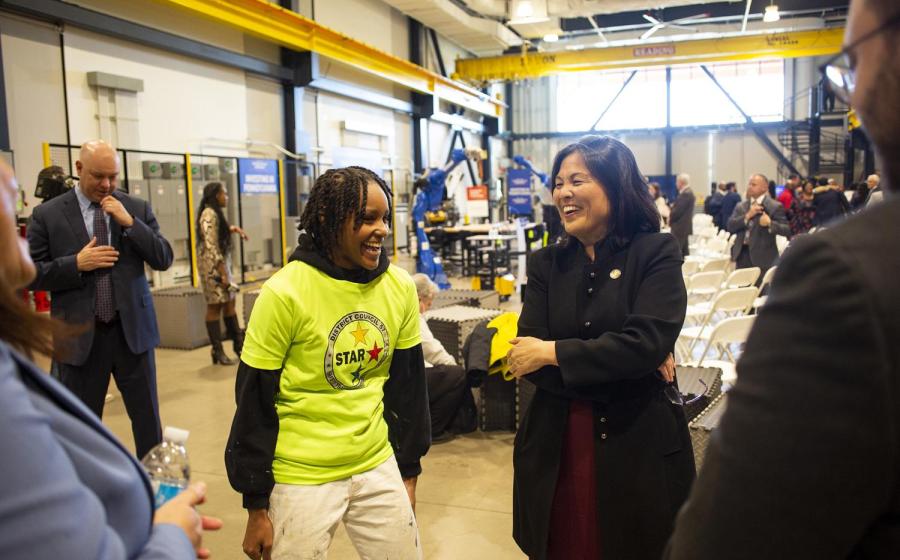(la Oficina del Defensor de Inmigrantes Detenidos) - La Oficina del Defensor de Inmigrantes Detenidos (OIDO) está aquí para ayudar a la comunidad de inmigrantes detenidos. La OIDO, una oficina independiente del Departamento de Seguridad Nacional (DHS) de EE. UU., se dedica a promover y apoyar condiciones seguras y humanas para las personas detenidas por motivos de inmigración. Como única entidad de supervisión del DHS centrada exclusivamente en la detención de inmigrantes, la OIDO cuenta con personal que visita regularmente las instalaciones para hablar con los detenidos sobre sus inquietudes. La Oficina también realiza inspecciones, ofrece recomendaciones y propone soluciones para mejorar las condiciones de detención de los inmigrantes.
- La Oficina del Defensor de Inmigrantes Detenidos (OIDO) está aquí para ayudar a la comunidad de inmigrantes detenidos. La OIDO, una oficina independiente del Departamento de Seguridad Nacional (DHS) de EE. UU., se dedica a promover y apoyar condiciones seguras y humanas para las personas detenidas por motivos de inmigración. Como única entidad de supervisión del DHS centrada exclusivamente en la detención de inmigrantes, la OIDO cuenta con personal que visita regularmente las instalaciones para hablar con los detenidos sobre sus inquietudes. La Oficina también realiza inspecciones, ofrece recomendaciones y propone soluciones para mejorar las condiciones de detención de los inmigrantes.
La OIDO cuenta con un equipo de expertos médicos que evalúan los casos individuales y asesoran sobre cuestiones sistémicas y políticas. El equipo está formado por asistentes médicos, enfermeros titulados, psicólogos y farmacéuticos que trabajan junto a los administradores de casos e investigadores de OIDO.
La OIDO adopta un enfoque neutral para observar y analizar los asuntos relacionados con las condiciones de detención de inmigrantes, al tiempo que destaca los problemas de tratamiento de forma oportuna. La OIDO se basa en las inspecciones anunciadas y no anunciadas de un equipo de investigadores dedicados que visitan centros de detención tanto administrados por el gobierno como contratados de forma privada en todo el país. La Oficina también coloca administradores de casos en los centros de detención de todo el país para gestionar quejas que van desde necesidades físicas como el acceso a mantas, cepillos de dientes y mejoras en la calidad de la comida, hasta garantizar que los centros de detención ofrezcan acceso suficiente a personal médico, zonas de videoconferencia y bibliotecas jurídicas.
Cuando se recurre a la OIDO para que ayude con asuntos que requieren atención inmediata y que no han sido resueltos por el Servicio de Aduanas y Protección de Fronteras (CBP) de EE. UU. o el Servicio de Inmigración y Control de Aduanas (ICE), la OIDO puede llamar la atención adicional sobre estos asuntos. Su trabajo puede dar lugar a una recomendación formal de mejora al Secretario del DHS, Alejandro Mayorkas, y al Congreso.
El año pasado, la OIDO emitió una Alerta al Defensor en relación con la falta crítica de personal médico de un contratista independiente en la frontera suroeste. Los expertos médicos de la OIDO colaboraron con la Oficina del Médico Jefe del CBP y con la Oficina de Servicios de Salud del DHS para abordar las deficiencias de la atención médica en todo el país, lo que se tradujo en índices de dotación de personal que han aumentado un 100% a nivel nacional este año. Tras una minuciosa investigación, el informe final, Análisis de la OIDO: Contrato de apoyo médico del CBP para la frontera suroeste y Tucson (OIDO Review - CBP Medical Support Contract for Southwest Border and Tucson), se publicó en julio.
Cuando se levantó el Título 42 en mayo, la OIDO movilizó personal a la frontera sur y estuvo presente en muchos emplazamientos de la Patrulla Fronteriza, al tiempo que continuaba con su labor habitual de supervisión en los centros de detención de inmigrantes. “La OIDO está comprometida con garantizar las mejores condiciones posibles para quienes se encuentran en nuestro sistema de detención de inmigrantes”, declaró el Defensor de Inmigrantes Detenidos interino, David Gersten. “Posicionamos a los administradores de casos y a los investigadores de todo el país para que tengan un acceso fácil a las instalaciones del ICE y del CBP, lo que nos permite resolver los problemas de detención de forma proactiva y lo más rápidamente posible”.
Los altos directivos de la OIDO también participaron en estas observaciones. Un área de enfoque crítica fue el cuidado de los niños no acompañados y de las familias, junto con las instalaciones adecuadas, la higiene, el acceso y la calidad de los alimentos y el agua, el acceso a los servicios jurídicos y el manejo de los bienes personales.
Las personas detenidas deben sentirse seguras sabiendo que solicitar ayuda a un administrador de casos de la OIDO no afecta a su estatus migratorio. Deben empezar por pedir hablar con un administrador de casos de la OIDO en su centro o hacer que un representante rellene un Formulario de admisión de casos para cualquier asunto relacionado con su bienestar que no haya sido tratado.
En un caso reciente, un detenido solicitó ayuda a un administrador de casos de la OIDO, afirmando que no se le permitía acceder a la documentación relacionada con la inmigración que tenía en su poder cuando llegó por primera vez al centro. El individuo informó a la OIDO de que se habían hecho múltiples peticiones de los documentos, pero estos no habían sido devueltos. Según las Normas de Detención del ICE, los centros de detención de inmigrantes deben permitir a las personas detenidas acceder a su documentación legal personal. Con el apoyo del administrador de casos de la OIDO, que transmitió esta queja al personal del centro, el individuo recibió rápidamente su documentación.
Con la misión de servir como recurso neutral, objetivo y creíble para todos los afectados por la detención de inmigrantes, la OIDO seguirá identificando los procesos que no funcionan como deberían y trabajando para obtener resultados. Se estima que para finales de este año, la OIDO habrá abordado más de 20,000 casos sobre las condiciones de detención.
“Nuestro objetivo es seguir mejorando eficaz y rápidamente las condiciones en todos los centros de detención, al trabajar para mitigar los problemas y mejorar los procesos del ICE y el CBP”, dijo Gersten.
Para obtener más información sobre la OIDO o presentar una queja, visite DHS.gov/OIDO.
 - Kids take the field in a big way this summer in Plano, Texas, as the town gears up to host a diverse mix of activities that attract the best young talent from across the United States.
- Kids take the field in a big way this summer in Plano, Texas, as the town gears up to host a diverse mix of activities that attract the best young talent from across the United States.


 - Youth sports are a formative experience for many kids, and provide opportunities not only to hone athletic abilities but also to develop strong character, values, and cooperative skills that will serve them well for life. The backbone of any team is its coach.
- Youth sports are a formative experience for many kids, and provide opportunities not only to hone athletic abilities but also to develop strong character, values, and cooperative skills that will serve them well for life. The backbone of any team is its coach.
 - La Semana del Aprendizaje Juvenil, una iniciativa del Departamento de Trabajo de EE. UU., presenta una variedad de eventos y oradores en lugares de todos los Estados Unidos para mostrar los numerosos beneficios de los programas de aprendizaje registrado para jóvenes y adultos jóvenes de 16 a 24 años.
- La Semana del Aprendizaje Juvenil, una iniciativa del Departamento de Trabajo de EE. UU., presenta una variedad de eventos y oradores en lugares de todos los Estados Unidos para mostrar los numerosos beneficios de los programas de aprendizaje registrado para jóvenes y adultos jóvenes de 16 a 24 años.
 - Our Nation mourns for the communities of Northern Florida, where residents were so tragically affected by Hurricane Idalia. The Marine Toys for Tots Program recognizes that need extends far beyond the holiday season, and we stand ready to assist when hope and relief are needed most.
- Our Nation mourns for the communities of Northern Florida, where residents were so tragically affected by Hurricane Idalia. The Marine Toys for Tots Program recognizes that need extends far beyond the holiday season, and we stand ready to assist when hope and relief are needed most.



 - Summer is peak season for music festivals and concerts, and fans are road tripping from coast to coast to experience their favorite artists live. But costs can add up quick.
- Summer is peak season for music festivals and concerts, and fans are road tripping from coast to coast to experience their favorite artists live. But costs can add up quick. 
 - When scuba diving instructor Jim Elliott first started teaching individuals with physical disabilities in 1997, he intuitively realized that diving also had therapeutic benefits for individuals with autism, down syndrome and other cognitive and learning impairments.
- When scuba diving instructor Jim Elliott first started teaching individuals with physical disabilities in 1997, he intuitively realized that diving also had therapeutic benefits for individuals with autism, down syndrome and other cognitive and learning impairments.
 - The local power company in Boise, Idaho, offered a monthly billing credit for residential customers who allowed them to remotely control their central air conditioning (A/C) system on a few weekdays when summer demand for energy exceeded the utility’s capacity.
- The local power company in Boise, Idaho, offered a monthly billing credit for residential customers who allowed them to remotely control their central air conditioning (A/C) system on a few weekdays when summer demand for energy exceeded the utility’s capacity. After visiting the website for the non-profit International Window Film Association (IWFA.com), she decided to investigate having window film installed to upgrade the existing windows.
After visiting the website for the non-profit International Window Film Association (IWFA.com), she decided to investigate having window film installed to upgrade the existing windows. 